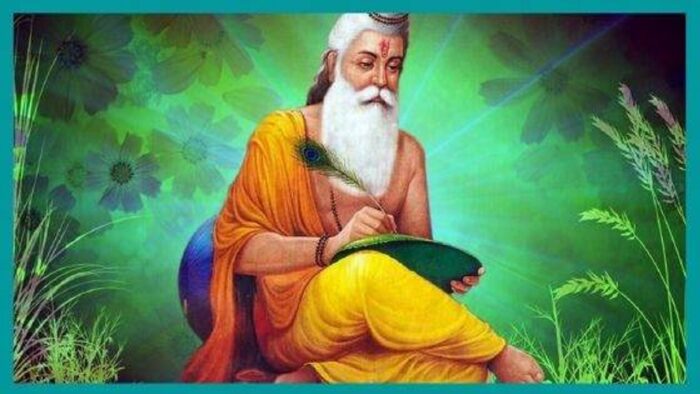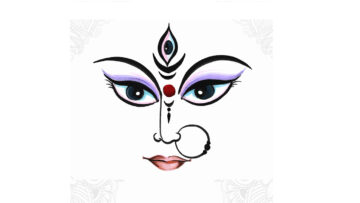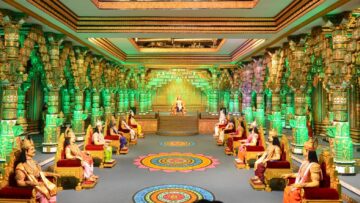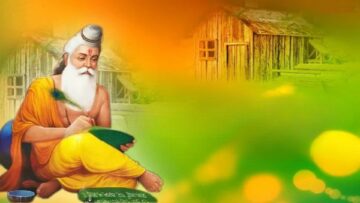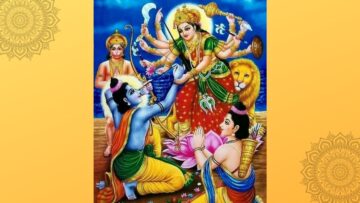In the sacred land of Bhārata, which recognizes spirituality as the basis of every art-form, it is not surprising that the greatest contribution in the evolution and development of arts and aesthetics comes from saints and ascetics. Be it the lakṣaṇa (theory) or the lakṣya (applied) side, the tallest figures of every aspect of aesthetics such as poetry, music, dance etc, are unmistakingly, the seers and anchorites. While Vālmīki the great ascetic was the first poet (Ādi-kavi), it is Nārada the celestial seer whose śikṣā is regarded as the first work of music. Nāṭya-Śāstra, the first work on poetics, dance and dramaturgy was exclusively entrusted to Bharata who is addressed by the adjectives of Vedaguhyajña (knower of the Vedic secrets) and Śaṁsitavrata (who has observed austerities). It is not just as the founding fathers, but throughout the history of Indian aesthetics, saints, philosophers and recluses have heralded some of the most important milestones in every field.
Regardless of their philosophical and theological differences, ācāryas from every sampradāya have made exceptional contributions to the various aspects of Indian aesthetics. Here, it behoves me to recall some of the great names and their works. Among the saints of Advaitic tradition were Vidyāraṇa (14th Cent) who composed the Saṅgītasāra, an important treatise on music that has been hailed by authorities like Govinda Dīkṣita, Śrī Appayya Dīkṣita (16th Cent), the great philosopher who gave twin treatises on poetics viz. Kuvalayānanda and Citramīmāṁsā, Śrī Nārayaṇa Tīrtha (17th Cent) composed the unparalleled operatic poem Śrī Kṛṣṇalīlā taraṅgiṇī, while, Siddhendra Yogi, his disciple is regarded as the founder of the Kūcipudi style of dance, Candra Śekharendra Sarasvatī V (17th Century), the pontiff of Kāmakoṭi Pīṭha who authored the operatic poem Śivagītimālā, Upaniṣad Brahmendra (17th Century), the great commentator on the 108 Upaniṣads composed another operatic work called Rāmāṣtapadī . From the Mādhva tradition, Śrī Nārāyaṇa Paṇḍitācārya (13th Century), composed mahākāvyas such as Uṣāharaṇa and Sumadhva-Vijaya, Vādirāja (15th Century) composed the Rugminīśa-vijaya, a poem on the life of Kṛṣṇa interspersed with the ideas of Madvācārya’s philosophy, Śrī Purandaradāsa, the grandsire of Karnataka Saṅgīta and the saints of the Haridasa movement. Śrī Vedānta Deśika (13th Cent), whose poetic skills could only be compared to Kālidāsa, was one of the greatest figures among the Śrī Vaiṣṇava ācāryas. Yadavābhyudaya, a mahākāvya, Saṅkalpasūryodaya, an allegorical play and Haṁsadūta, a lyrical poem are notable among his works. The Gauḍiya Vaiṣṇava sampradāya shall ever be remembered for its exclusive contribution to the lakṣya and lakṣaṇa aspects of aesthetics. Rūpa Gosvāmi (15th Cent) composed the Bhakti-rasamṛta-sindhu, Ujjvalanīlamaṇi and Nāṭaka-candrika as treaties on poetics and dramas revolving around Kṛṣṇa-bhakti, dramas such as Vidagdhamadhava, Lalitamādhava and Dānakelikaumudi and poems such as Haṁsa-dūta and Uddhava-Sandeśa. His nephew, Jīva Gosvāmi composed Bhakti-rasamṛtaśeṣa, a work on rhetorics and literary work called Gopala-Campu, Baladeva Vidyābhūṣaṇa (18th Cent) composed Kāvyakaustubha and Sāhitya-Kaumudi on poetics. From the Nimbarka tradition there was Svāmi Haridāsa, the poet and musician who is one of the most revered figures in the North Indian style of music. Ācārya Sankaradeva is credited with the creation of Sattriya, the classical dance style from Assam. This continues till today and we are fortunate to live in the era of Sri Rambhadracharya, the pontiff of Tulasī pīṭha who is one of the greatest poets of the 21st Century.
The role of these saintly personages was of a greater importance in the systematic postulation of Bhakti as the major sentiment in the sphere of pure aesthetics. Bharata recognized eight rasas (aesthetic sentiments) viz. śṛngāra, hāsya, karuṇa, raudra, vīra, bhayānaka, bībhatsa and adbhuta. Conscious of the fact that the aesthetic experience of the spectator cannot be restricted to the above eight and that a few other emotions such as tranquility, filial affection, friendship etc as capable of evoking rasa, the later rhetoricians legitimately recognized śānta, vatsala etc, as rasas. The most beautiful sentiment of bhakti or devotion was yet to get its due, for most of the critics either classified bhakti as devādiviṣayā rati, a distinct emotion (bhāva) or identified bhakti as śānta. Bhakti with its numerous shades could not be confined to śānta nor the emotion capable of evoking a transcendental delight could remain a theoretical bhāva.
Foremost among the advocates of the theory of bhakti as the supreme rasa absorbing every other sentiment within its ambit were Śrī Vopadeva, Śrī Madhusūdana Sarasvatī and Śrīla Rūpa Gosvamī. It is owing to their cogent thesis and unambiguous interpretation that bhakti emerged as the soul of every branch of Indian aesthetics and continues till date. Madhusūdana Sarasvatī, the great Advaitic philosopher of the 16th Century presents a fresh and original exposition of bhakti as a subject matter of aesthetics in his Bhagavad-Bhakti-rasāyana– the elixir of devotion. The Bhagavad-Bhakti-rasāyana is a short yet remarkable work on aesthetics comprising about 140 verses divided into three chapters systematically dealing with bhakti and the mental instincts, the varieties of bhakti-rasa and its superiority and aesthetic concepts respectively. The following section is an attempt to annotate some of the striking aspects of this work.
Madhusūdana Sarasvatī commences his work with a proposition clearly stating his endeavour to expound bhakti from the perspective of aesthetics. His words are as follows:
नवरसमिलितं वा केवलं वा पुमर्थं परममिह मुकुन्दे भक्तियोगं वदन्ति।
निरुपमसुखसंविद्रूपमसृष्टदुःखं तमहमखिलतुष्ट्यै शास्त्रदृष्ट्या व्यनज्मि॥ (Bhagavad-Bhakti-rasāyana.I.1)
Every word here is significant and reveals the nature of bhakti. He describes devotion unto Mukunda as parama pumartha (highest human pursuit), aspṛṣṭaduḥkha (untouched by sorrow), nirupamasukhasaṁvidrūpa (whose form is of the experience of an incomparable bliss). Bhakti, he says, is either combined with the nine sentiments or independent, which will be established further.
According to traditional Indian aesthetics, it is the sthāyi- bhāva (ever-lasting latent mental impressions), that manifest as rasa (aesthetic bliss) by the combination of the vibhāvas (determinants), anubhāvas (consequents) and the vyabhicārī bhāvas (transitory moods) described in a literary or dramatic work. Madhusūdana Sarasvatī goes deeper and introduces the concept of ‘druti’ or the dissolving of the mind. With the idea of druti as the common factor, Śrī Madhusūdana Sarasvatī brings together the concepts of bhakti and sthāyi- bhāva.
Madhusūdana Sarasvatī defines bhakti as :
द्रुतस्य भगवद्धर्माधारावाहिकतां गता। सर्वेशे मनसो वृत्तिः भक्तिरित्यभिधीयते॥
(Bhagavad-bhaktirasāyana.I.3)
“That state of mind, where the mind which is dissolved (dravībhūta) by the practice of bhagavad-dharma, ceaselessly flows towards the Supreme Deity”. In other words, it is a mind longing for the Lord. Following the idea of Bhāgavatam that mentions of an insect attaining the state of a wasp, by its constant contemplation[1] of the latter, Madhusūdana Sarasvatī in his commentary explains bhakti as bhagavadākārata (the form of the Lord) of the mind[2].
Another interesting conception of Madhusūdana Sarasvatī is that, according to him, as far as bhakti-rasa is concerned, the Lord is both, the ālambana-vibhāva (on whom the emotion rests) as well as the sthāyi- bhāva. He says, rati, the sthāyi bhāva of bhakti is nothing but the impressions of the Lord’s form entering the mind in its molten state. –
रतिर्नाम भक्तिरसस्थायिभावो द्रुतचित्तप्रविष्टभगवदाकारतारूपसंस्कारविशेषः (commentary on I.36)
This contradiction is resolved by the maxim of the image and its reflection. While the Lord is the bimba, the mind that has assumed the form of the God is the pratibimba. It is this very Lord, the embodiment of Supreme bliss who becomes manifest as the rasa–
भगवान्परमानन्दस्वरूपः स्वयमेव हि। मनोगतस्तदाकारो रसतामेति पुष्कलम्॥ (Bhagavad-bhakti-rasāyana. I.10)
About the mind and its druti, he says that the mind is as hard as lac and the instincts such as kāma (conjugal love), etc., are the factors that bring about the dissolving of the mind. The mind when in contact with these is dissolved, and hardens once they are withdrawn. Just as the color mixed with lac in its molten state remains forever, the objects of the mind in its dissolved state permanently remains as vāsanas or impressions, this is the same as sthāyi- bhāva. Thus the Lord entering the mind in its dissolved state, remains in the mind as sthāyi and manifests as the complete rasa.
In chapter II of the work, Madhusūdana Sarasvatī classifies bhakti on the basis of factors that bring about the dissolving of the mind. These factors are kāma (conjugal love), two-fold dveṣa (anger) arising out of hatred and love, two-fold bhaya (fear) arising out of hatred and love, sneha (non-conjugal forms of love such as parental-love, friendship and servitude), harṣa (joy) which includes śuddha-harṣa (pure devotion), hāsa (laughter), adbhuta (wonder), four-fold utsāha (perseverance) viz. yuddhotsāha (martial spirit), dayotsāha (pity), dānotsāha (charity) and dharmotsāha (piety), śoka (sorrow), dayā or ghṛṇa (revulsion) and śama (tranquility) .He goes on to explain all the instincts in detail and asserts that there can be no instincts more than the aforesaid sixteen (II.25) and that these determine the sthāyi bhāvas which in turn manifest as rasa when vibhāvas etc., combine. Out of these he excludes dharmotsāha, dayotsāha, ghṛṇā and dveṣa (hatred) arising out of jealousy or fear as the causes of the sthāyi bhāvas for bhakti, as they cannot have the Lord as their object. Therefore he does not recognize dharmavīra, dayāvīra, śānta, raudra and bhayānaka. According to him, the bhakti-rasas are śṛngāra (erotic), karuṇa (pathetic), hāsya (comic) , prītibhayānaka (terrific sentiment arising out of love), adbhuta (wonder), yuddhavīra (heroic), dānavīra (benevolence), vatsala (paternal love) preyas (friendship) and viśuddha (pure devotion). Viśuddha-bhakti-rasa arises out of the śuddharati, pure devotion, which is determined by the harṣa caused by greatness of the Lord who is full of bliss[3]. Thus Madhusūdana Sarasvatī establishes his preposition of expounding bhakti-rasa which is either alloyed with the nine-sentiments or as is independent (kevala). This independent bhakti is what is called viśuddha, while the rest are the forms of bhakti alloyed with the sentiments.
Madhusūdana Sarasvatī vehemently refutes the opinion of the critics of bhakti-rasa who classify bhakti as a bhāva- devādiviṣaya-rati (love towards Gods and the likes). He says:
रतिर्देवादिविषया व्यभिचारी तथोर्जितः। भावः प्रोक्तो रसो नेति यदुक्तं रसकोविदैः॥
देवान्तरेषु जीवत्वात् परानन्दप्रकाशनात्। तद्योज्यं परमानन्दरूपे न परमात्मनि॥
(Bhagavad-bhakti-rasāyana.II. 73-74)
“The concept of devādiviṣaya-rati holds good in case of minor deities, for they are jīvas. This is not applicable to Kṛṣṇa, the Paramātmā, who is the embodiment of the Supreme bliss”. As compared to the minor emotions such as conjugal love, which only evoke a rasa which is partially blissful, bhakti-rasa evokes complete bliss. The latter is like the Sun, while the former are only comparable to the fire-flies with respect to the degree of bliss. He then ridicules the ignorance of such aestheticians on logical grounds. He says, “When emotions such as anger, sorrow and fear, which are certainly contrary to bliss are accepted as rasa, on the grounds of experience of aesthetic bliss, why do the fools prattle about bhakti, when one experiences bliss that is thousand-fold”[4].
The two most significant observations in Chapter III are the unambiguous statements made by Sri Madhusūdana Sarasvatī about the blissful nature of all the rasas and the seat of rasa. He says the sthāyi-bhāvas that are described in literary works (bodhya) are worldly, while the sthāyins residing in the minds of the spectator are transcendental. The former are of the nature of dualities, but the latter lead to pure bliss, as a result even sentiments such as karuṇa are pleasurable[5].
The contribution of Madhusūdana Sarasvatī to aesthetics is not confined to the theorization of bhakti-rasa. He was also a first-rate poet and playwright who composed a seven-act play titled Kṛṣṇa-kutūhalam, perhaps to illustrate his theory of bhakti-rasa. The drama belongs to the nāṭaka genre of Sanskrit plays and revolves around Kṛṣṇa’s pastimes at Vrndavana. The principal sentiment of the drama is śṛngāra-bhakti, sentiments of hāsya, yuddhavīra, preyas, prītibhayānaka, adbhuta etc, are effectively delineated as the sub-ordinate sentiments at appropriate places. As a playwright Madhusūdana Sarasvatī excels in embellishing the plot derived from the Bhagavata Purāṇa and the Padma-Purāṇa by his original creative touches. The drama bears impressions of Bhavabhūti’s Uttara-Ramacaritam. Every act is named after the subject matter dealt with in it.
Like Bhavabhūti, Madhusūdana Sarasvatī introduces Vanadevī as a sympathiser of the union of Radha and Kṛṣṇa, and also introduces a garbhāṅka (an act within an act) in the Act VII. However Madhusūdana Sarasvatī‘s conception of the garbhāṅka is extraordinary. The garbhāṅka is comprised of a play titled Kaṁsavadha, written by Nārada which is staged with Bharati Muni as the sūtradhāra, Vātsyayana as his assistant, sages Asita and Devala playing the roles of Balarāma and Kṛṣṇa, Kāśyapa as Nanda and Vasudeva, Aditi as Yaśodā and Devakī, Indra and other deities as the cowherds and the celestial women as the Gopis, Vyāsa as Akrūra and goblins (pramathas) playing the roles of Kaṁsa and other demonic characters. The drama of Madhusūdana Sarasvatī ends with Balarāma and Kṛṣṇa lauding the play of Nārada which is staged after Kṛṣṇa kills Ariṣṭāsura.
Apart from his contribution to philosophy, the lakṣya and lakṣaṇa aspects of aesthetics, Madhusūdana Sarasvatī will ever be cherished unhesitatingly stating the purpose of the arts in his work Prasthānabheda. Here he says:
एवं गन्धर्वशास्त्रं भगवता भरतेन प्रणीतम्। गीतवाद्यनृत्तभेदेन बहुविधोऽर्थः। देवताराधननिर्विकल्पसमाध्यादिसिद्धिश्च गान्धर्ववेदस्य प्रयोजनम्॥
The Gandharvaveda, comprised of vocal music, instrumental music, dance and the likes was propounded by sage Bharata. Their purpose is to serve the Lord, to experience the state of nirvikalpa-samādhi (absolute union with the Supreme) and the likes.
Although stated in brief, the words are of utmost importance in the realm of arts. Even while satiating their creative urge through the art form, artistes are expected to remember the ultimate spiritual purpose of these very art forms to keep their true spirit alive.
[1] Śrīmad-Bhāgavatam-XI.9.23
[2] Ibid. commentary on I. III
[3] ibid.(II.12-13)
[4] (Bhagavad-Bhakti-rasāyana. II.78-79)
[5] Ibid. (III.4-6)
Conference on Hindu Aesthetics
Image credit: wikireligions.com
Watch video presentation of the above paper here:
Disclaimer: The opinions expressed in this article belong to the author. Indic Today is neither responsible nor liable for the accuracy, completeness, suitability, or validity of any information in the article.

